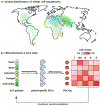Sickle cell disease in the era of precision medicine: looking to the future
- PMID: 33015364
- PMCID: PMC7531762
- DOI: 10.1080/23808993.2019.1688658
Sickle cell disease in the era of precision medicine: looking to the future
Abstract
Introduction: Sickle cell anemia is a mendelian disease that is noted for the heterogeneity of its clinical expression. Because of this, providing an accurate prognosis has been a longtime quest.
Areas covered: Reviewed are the benefits and shortcomings of testing for the major modulators of the severity of disease, like fetal hemoglobin and α thalassemia, along with studies that have attempted to link genetic variation with sub-phenotypes of disease in a predictive fashion. Induced pluripotent stem cells driven to differentiate into erythroid precursor cells provide another area for potential patient-specific drug testing.
Expert opinion: Fetal hemoglobin is the strongest modulator of sickle cell anemia but simply measuring its blood levels is an insufficient means of forecasting an individual's prognosis. A more precise method would be to know the distribution of fetal hemoglobin levels across the population of red cells, an assay not yet available. Prognostic measures have been developed using genetic and other signatures, but their predictive value is suboptimal. Widely applicable assays must be developed to allow a tailored approach to using the several new treatments that are likely to be available in the near future.
Keywords: Fetal hemoglobin; GWAS; SNPs; genetic signatures; hemolysis; iPSCs; vasoocclusion.
Conflict of interest statement
Declaration of interest The authors have no other relevant affiliations or financial involvement with any organization or entity with a financial interest in or financial conflict with the subject matter or materials discussed in the manuscript apart from those disclosed.
Figures


Similar articles
-
Acute chest syndrome of sickle cell disease: genetics, risk factors, prognosis, and management.Expert Rev Hematol. 2022 Feb;15(2):117-125. doi: 10.1080/17474086.2022.2041410. Epub 2022 Feb 16. Expert Rev Hematol. 2022. PMID: 35143368
-
Minireview: Genetic basis of heterogeneity and severity in sickle cell disease.Exp Biol Med (Maywood). 2016 Apr;241(7):689-96. doi: 10.1177/1535370216636726. Epub 2016 Mar 1. Exp Biol Med (Maywood). 2016. PMID: 26936084 Free PMC article. Review.
-
Targeting fetal hemoglobin expression to treat β hemoglobinopathies.Expert Opin Ther Targets. 2022 Apr;26(4):347-359. doi: 10.1080/14728222.2022.2066519. Epub 2022 Apr 26. Expert Opin Ther Targets. 2022. PMID: 35418266
-
Phenotypic variation in sickle cell disease: the role of beta globin haplotype, alpha thalassemia, and fetal hemoglobin in HbSS.Expert Rev Hematol. 2022 Feb;15(2):107-116. doi: 10.1080/17474086.2022.2040984. Epub 2022 Mar 7. Expert Rev Hematol. 2022. PMID: 35143361
-
Genetic modifiers of sickle cell disease.Am J Hematol. 2012 Aug;87(8):795-803. doi: 10.1002/ajh.23232. Epub 2012 May 28. Am J Hematol. 2012. PMID: 22641398 Free PMC article. Review.
Cited by
-
In vivo evaluation of the effect of sickle cell hemoglobin S, C and therapeutic transfusion on erythrocyte metabolism and cardiorenal dysfunction.Am J Hematol. 2023 Jul;98(7):1017-1028. doi: 10.1002/ajh.26923. Epub 2023 Apr 3. Am J Hematol. 2023. PMID: 36971592 Free PMC article.
-
Evaluation of 2D and 3D Erythroid Differentiation Protocols Using Sickle Cell Disease and Healthy Donor Induced Pluripotent Stem Cells.Cells. 2023 Apr 10;12(8):1121. doi: 10.3390/cells12081121. Cells. 2023. PMID: 37190030 Free PMC article.
-
Automated Oxygen Gradient Ektacytometry: A Novel Biomarker in Sickle Cell Anemia.Front Physiol. 2021 Mar 25;12:636609. doi: 10.3389/fphys.2021.636609. eCollection 2021. Front Physiol. 2021. PMID: 33841173 Free PMC article.
-
Microfluidic methods to advance mechanistic understanding and translational research in sickle cell disease.Transl Res. 2022 Aug;246:1-14. doi: 10.1016/j.trsl.2022.03.010. Epub 2022 Mar 27. Transl Res. 2022. PMID: 35354090 Free PMC article. Review.
References
-
- Garner C, Tatu T, Reittie JE, et al. Genetic influences on F cells and other hematologic variables: a twin heritability study. Blood 2000;95:342–346. - PubMed
-
- Dover GJ, Boyer SH, Charache S, et al. Individual Variation in the Production and Survival of F Cells in Sickle-Cell Disease. N. Engl. J. Med 1978;299:1428–1435. - PubMed
-
- Kato GJ, Steinberg MH, Gladwin MT. Intravascular hemolysis and the pathophysiology of sickle cell disease. J. Clin. Invest 2017;127:750–760. - PMC - PubMed
-
This review provides background and evidence for the dichotomization of sickle cell pathophysiology into events associated with vasoocclusion and intravascular hemolysis.
Grants and funding
LinkOut - more resources
Full Text Sources
